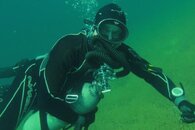Hank, I'm right there with ya


I'm not an instructor and don't really worry about liability but I do have the advantage of being interested in the origins of diving and studying practices of the past as well as the modern era, so I have an understanding of what skills fit where.
In the past, at the most basic level, a diver had a foundation in skin diving techniques. This provided the diver with comfort floating, descending, and ascending and relating to the water column in three dimensions. "Swim down, swim around, swim up" (as Nemrod likes to say). That's why I can do what I am in the picture. I am just skin diving with a compressed air tank. The skills mastered were efficient movement, buoyancy control, safeguarding buddies and reading water conditions.
Basic diving takes those core skills and adds the use of compressed air to prolong the "swim around" portion. Some new skills and knowledge, mainly to do with using compressed gas, remaining buddies, monitoring time and depth etc... but still the same basic "swim down, swim around, swim up" paradigm exists. Any diver, may call any dive, at any time.
Sadly, modern instruction generally needs to instill both the skill sets of skin diving and basic diving into students, as many have no prior experience in the water. That is one reason why some students may become overloaded and not develop those skills adequately. It's not the instructors fault - they are really doing double duty with one course. Non divers should be coming to them with buoyancy skills, experience floating, diving down and ascending, experience with mask fins and snorkel and general confidence being in the water.
Advanced diving builds on those skills and adds the complication of advanced environmental conditions dictating delayed/difficult access to the surface (current, boat traffic, Kelp, depth, ice...). Gasses like EAN may be used but the diver still remains within NDL limits. New knowledge and skills acquisition and a new paradigm to observe. No longer can one count on an automatic direct ascent to the surface. Now we explore either stronger buddy skills, redundancy or both.
Technical diving takes those skills and adds the complication of an emphatic "no direct access to the surface" mindset (deco, cave, wreck). divers must learn to solve their problems at depth. Decompression theory is introduced. New knowledge and skills and there is a further move into the paradigm introduced at the advanced level.
When you can see the whole picture you can see why some strategies do not make sense at some points.




